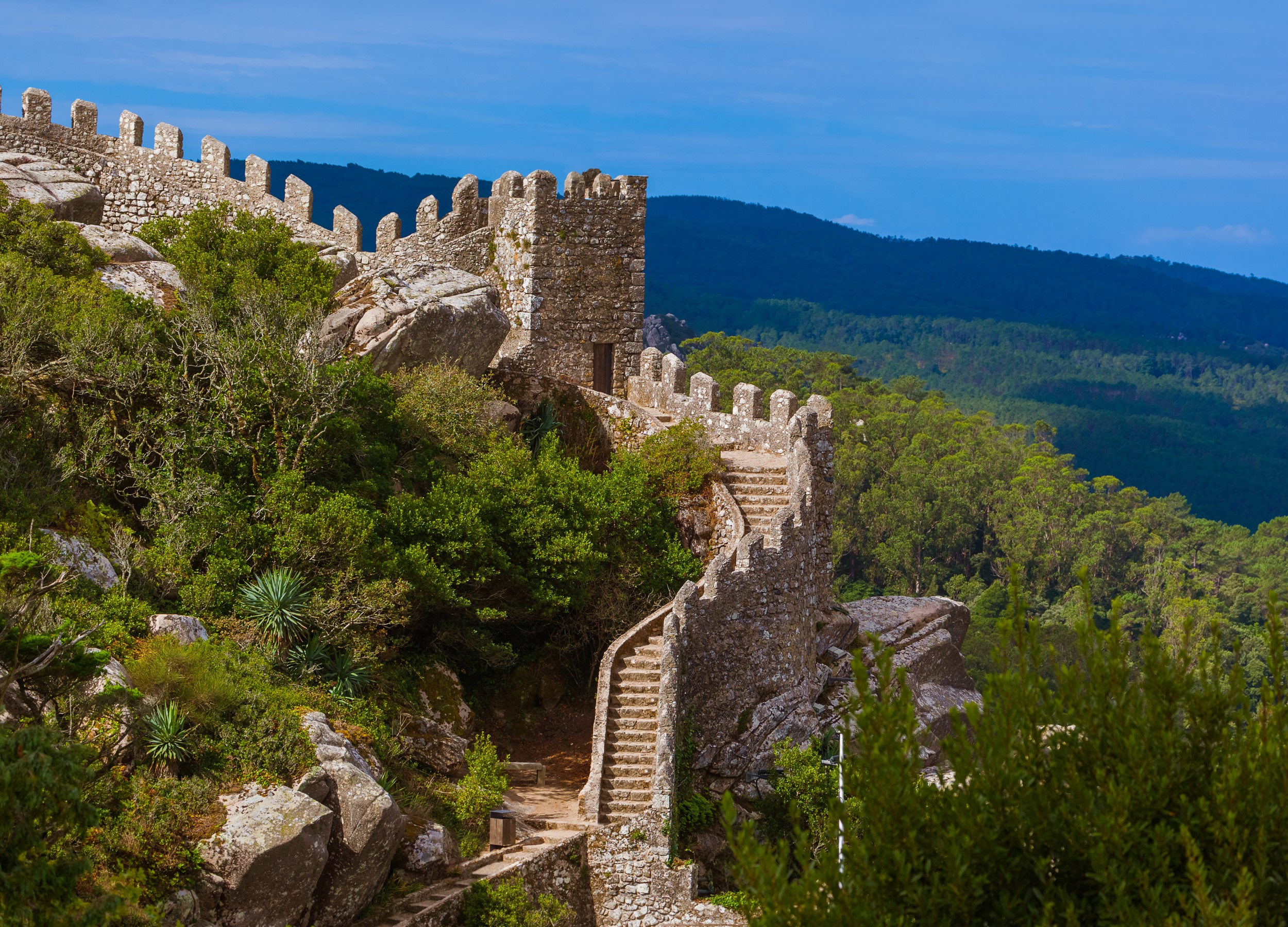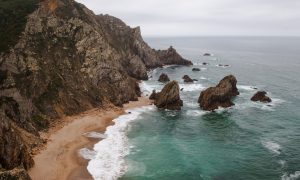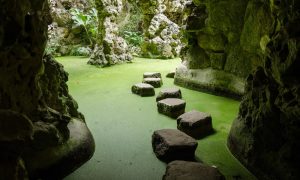The Enigmatic Moorish Castle of Sintra: A Journey Through Time
Perched high atop the Serra de Sintra’s lush, mist-covered hills, the Moorish Castle (Castelo dos Mouros) stands as a sentinel of Portugal’s layered history. This ancient fortress, with its serpentine walls and rugged battlements, offers not just panoramic views but a profound connection to the epochs that have shaped the Iberian Peninsula. Join me as we delve deep into the castle’s storied past, architectural marvels, and the practicalities of visiting this monumental site.
A Tapestry Woven Through Centuries: The History of the Moorish Castle
Origins in the Islamic Period
The Moorish Castle dates back to the 8th or 9th century during the early days of the Islamic presence in the Iberian Peninsula. Established by the Moors—Muslim inhabitants from North Africa—the fortress was strategically built to oversee the Atlantic coast and safeguard the agricultural hinterlands of Sintra.
The Christian Reconquest
In 1147, the castle fell to King Afonso Henriques, the first monarch of Portugal, during the Christian Reconquest (Reconquista). This pivotal moment not only expanded Portuguese territory but also signified a cultural and religious shift. The castle was reinforced and maintained as a military outpost to defend against potential Moorish counterattacks.
Decline and Romantic Revival
By the 15th century, the castle’s military importance waned, leading to neglect and deterioration. The catastrophic earthquake of 1755 further reduced it to ruins. However, in the 19th century, King Ferdinand II, an ardent patron of the arts and architecture, initiated a revival. Embracing the Romantic spirit, he transformed the castle into a landscaped ruin, harmonizing it with the natural surroundings and the nearby Pena Palace.
Architectural Marvels: A Blend of Functionality and Romanticism
The Defensive Walls and Battlements
The castle’s walls stretch across the hilltops, adapting to the rugged terrain. Built with local granite stones, the walls feature crenellations and arrow slits, testifying to their defensive purpose. Walking along these ramparts, visitors can trace the footsteps of ancient sentinels while absorbing sweeping vistas of Sintra, its palaces, and the distant ocean.
The Towers
- Royal Tower (Torre Real): The highest point of the castle, offering unparalleled views. Historically used as a lookout to spot incoming ships or armies.
- Ferreira Tower: Named after a local noble family, this tower adds to the defensive complexity of the fortress.
The Cistern
An ingenious feat of Moorish engineering, the large underground cistern ensured a continuous water supply during sieges. Its vaulted chamber, capable of holding substantial water reserves, reflects the Moors’ advanced understanding of hydraulics.
Archaeological Discoveries
Ongoing excavations have unearthed artifacts spanning Islamic, medieval Christian, and even prehistoric periods. Items such as ceramics, coins, and everyday utensils provide valuable insights into the lives of former inhabitants.
The Journey to the Castle: An Adventurous Ascent
Reaching the Moorish Castle
Hiking Trails
- Via Vila Sassetti: A scenic route starting near the town center, winding through gardens and forests. It is moderately challenging but rewards hikers with serene natural beauty.
- Santa Maria Trail: A steeper path beginning at the Church of Santa Maria. This trail is shorter but requires good physical fitness.
By Public Transport
- Scotturb Bus 434: Operates from Sintra train station, looping through major sites including the Moorish Castle and Pena Palace. It’s convenient but can be crowded during peak seasons.
Driving
- Parking Constraints: Limited parking near the castle; roads are narrow and can be congested. Not recommended during tourist high season.
Physical Considerations
- Terrain: Uneven surfaces, steep stairs, and narrow passages. Suitable for visitors with good mobility.
- Footwear: Sturdy walking shoes are essential.
Planning Your Visit: Essential Information
Opening Times
- Summer (March 27 – October 29): Daily from 9:30 AM to 8:00 PM (Last entry at 7:00 PM).
- Winter (October 30 – March 26): Daily from 10:00 AM to 6:00 PM (Last entry at 5:00 PM).
Note: Opening hours may vary on public holidays. Always check the official Parques de Sintra website before planning your visit.
Ticket Prices
- Adults (18-64 years): €8.00
- Youth (6-17 years): €6.50
- Senior (over 65 years): €6.50
- Family Ticket (2 adults + 2 youths): €26.00
Combined tickets with other attractions like the Pena Palace are available at discounted rates.
Facilities
- Visitor Center: Offers maps, brochures, and multilingual information.
- Rest Areas: Benches and shaded spots along the pathways.
- Cafeteria: Light snacks and beverages available near the entrance.
Enhancing Your Experience: Tips and Insights
Optimal Visiting Times
- Early Morning or Late Afternoon: Fewer crowds and softer lighting for photography.
- Weekdays: Generally less busy than weekends.
Weather Considerations
- Microclimate: Sintra’s elevation and proximity to the Atlantic create a unique microclimate. Mornings can be misty, and sudden weather changes are common.
- Attire: Layered clothing recommended. Bring a waterproof jacket during autumn and winter months.
Guided Tours
- Benefits: Knowledgeable guides provide historical context, architectural details, and fascinating anecdotes.
- Languages: Tours are typically available in English, Portuguese, and Spanish.
Delving Deeper: Unveiling Hidden Gems
The Secret Passages
- Exploration: Parts of the castle feature hidden nooks and less-traveled pathways. These areas offer intimate encounters with the site’s history away from the main tourist routes.
The Surrounding Flora
- Biodiversity: The castle is enveloped by dense forests of pine, oak, and ferns. The unique combination of Mediterranean and Atlantic vegetation creates a rich tapestry of flora.
- Romantic Landscaping: King Ferdinand II’s restoration included planting exotic species and creating viewpoints that blend seamlessly with the natural environment.
The Castle at Night
- Occasional Events: The castle sometimes hosts evening events, including concerts and theatrical performances. The illuminated walls against the night sky create a magical ambiance.
The Moorish Castle’s Place in Modern Portugal
UNESCO World Heritage Site
- Cultural Landscape of Sintra: In 1995, UNESCO designated Sintra as a World Heritage Site for its 19th-century Romantic architecture and landscapes, with the Moorish Castle being a central element.
Educational Importance
- Archaeological Research: The site serves as an open-air laboratory for historians and archaeologists, contributing to academic knowledge and preservation efforts.
Symbol of Cultural Fusion
- Multicultural Legacy: The castle embodies the confluence of Islamic and Christian cultures, reflecting the complex history of coexistence, conflict, and integration in Portugal.
Conclusion: A Timeless Sentinel Worth Discovering
Visiting the Moorish Castle is more than a touristic endeavor—it’s an immersive journey through time. The fortress not only offers commanding views and Instagram-worthy shots but also invites contemplation of the myriad narratives woven into its stones. From the echoes of Moorish prayers to the strategizing whispers of Christian knights, and the Romantic musings of a king enthralled by beauty, the castle stands as a testament to human creativity, resilience, and the enduring allure of history.
So lace up your hiking boots, charge your camera, and prepare your mind for a deep dive into one of Portugal’s most enigmatic treasures. The Moorish Castle awaits, its ancient walls eager to share their stories with those willing to listen.





















